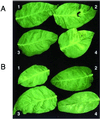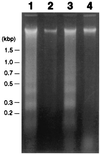Abrogation of disease development in plants expressing animal antiapoptotic genes
- PMID: 11381106
- PMCID: PMC34460
- DOI: 10.1073/pnas.091108998
Abrogation of disease development in plants expressing animal antiapoptotic genes
Erratum in
- Proc Natl Acad Sci U S A. 2003 Sep 30;100(20):11816
Abstract
An emerging topic in plant biology is whether plants display analogous elements of mammalian programmed cell death during development and defense against pathogen attack. In many plant-pathogen interactions, plant cell death occurs in both susceptible and resistant host responses. For example, specific recognition responses in plants trigger formation of the hypersensitive response and activation of host defense mechanisms, resulting in restriction of pathogen growth and disease development. Several studies indicate that cell death during hypersensitive response involves activation of a plant-encoded pathway for cell death. Many susceptible interactions also result in host cell death, although it is not clear how or if the host participates in this response. We have generated transgenic tobacco plants to express animal genes that negatively regulate apoptosis. Plants expressing human Bcl-2 and Bcl-xl, nematode CED-9, or baculovirus Op-IAP transgenes conferred heritable resistance to several necrotrophic fungal pathogens, suggesting that disease development required host-cell death pathways. In addition, the transgenic tobacco plants displayed resistance to a necrogenic virus. Transgenic tobacco harboring Bcl-xl with a loss-of-function mutation did not protect against pathogen challenge. We also show that discrete DNA fragmentation (laddering) occurred in susceptible tobacco during fungal infection, but does not occur in transgenic-resistant plants. Our data indicate that in compatible plant-pathogen interactions apoptosis-like programmed cell death occurs. Further, these animal antiapoptotic genes function in plants and should be useful to delineate resistance pathways. These genes also have the potential to generate effective disease resistance in economically important crops.
Figures






References
-
- Whitham S, Dinesh-Kumar S D, Choi D, Hehl R, Corr C, Baker B. Cell. 1994;78:1101–1115. - PubMed
-
- Dwyer S C, Leoendre L, Low P S, Leto T L. Biochem Biophys Acta. 1996;1289:231–237. - PubMed
-
- Lockshin R A, Zakeri Z, Tilly J L. When Cells Die. New York: Wiley–Liss; 1998.
-
- Steller H. Science. 1995;267:1445–1449. - PubMed
Publication types
MeSH terms
Substances
LinkOut - more resources
Full Text Sources
Other Literature Sources
Research Materials
Miscellaneous

